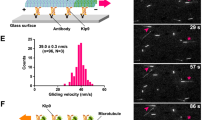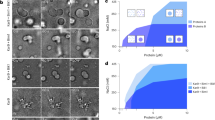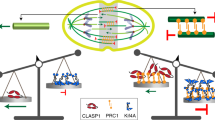Abstract
Regulation of microtubule polymerization and depolymerization is required for proper cell development. Here, we report that two proteins of the Drosophila melanogaster kinesin-13 family, KLP10A and KLP59C, cooperate to drive microtubule depolymerization in interphase cells. Analyses of microtubule dynamics in S2 cells depleted of these proteins indicate that both proteins stimulate depolymerization, but alter distinct parameters of dynamic instability; KLP10A stimulates catastrophe (a switch from growth to shrinkage) whereas KLP59C suppresses rescue (a switch from shrinkage to growth). Moreover, immunofluorescence and live analyses of cells expressing tagged kinesins reveal that KLP10A and KLP59C target to polymerizing and depolymerizing microtubule plus ends, respectively. Our data also suggest that KLP10A is deposited on microtubules by the plus-end tracking protein, EB1. Our findings support a model in which these two members of the kinesin-13 family divide the labour of microtubule depolymerization.
This is a preview of subscription content, access via your institution
Access options
Subscribe to this journal
Receive 12 print issues and online access
$209.00 per year
only $17.42 per issue
Buy this article
- Purchase on Springer Link
- Instant access to full article PDF
Prices may be subject to local taxes which are calculated during checkout







Similar content being viewed by others
References
Howard, J. & Hyman, A.A. Dynamics and mechanics of the microtubule plus end. Nature 422, 753–758 (2003).
Mitchison, T. & Kirschner, M. Dynamic instability of microtubule growth. Nature 312, 237–242 (1984).
Cassimeris, L. & Spittle, C. Regulation of microtubule-associated proteins. Int. Rev. Cytol. 210, 163–226 (2001).
Belmont, L.D., Hyman, A.A., Sawin, K.E. & Mitchison, T.J. Real-time visualization of cell cycle-dependent changes in microtubule dynamics in cytoplasmic extracts. Cell 62, 579–589 (1990).
Small, J.V. & Kaverina, I. Microtubules meet substrate adhesions to arrange cell polarity. Curr. Opin. Cell Biol. 15, 40–47 (2003).
Krylyshkina, O. et al. Nanometer targeting of microtubules to focal adhesions. J. Cell Biol. 161, 853–859 (2003).
Wittmann, T., Bokoch, G.M. & Waterman-Storer, C.M. Regulation of leading edge microtubule and actin dynamics downstream of Rac1. J. Cell Biol. 161, 845–851 (2003).
Lawrence, C.J. et al. A standardized kinesin nomenclature. J. Cell Biol. 167, 19–22 (2004).
Vale, R.D. & Fletterick, R.J. The design plan of kinesin motors. Annu. Rev. Cell Dev. Biol. 13, 745–777 (1997).
Desai, A., Verma, S., Mitchison, T.J. & Walczak, C.E. Kin I kinesins are microtubule-destabilizing enzymes. Cell 96, 69–78 (1999).
Walczak, C.E., Mitchison, T.J. & Desai, A. XKCM1: a Xenopus kinesin-related protein that regulates microtubule dynamics during mitotic spindle assembly. Cell 84, 37–47 (1996).
Rogers, G.C. et al. Two mitotic kinesins cooperate to drive sister chromatid separation during anaphase. Nature 427, 364–370 (2004).
Kline-Smith, S.L., Khodjakov, A., Hergert, P. & Walczak, C.E. Depletion of centromeric MCAK leads to chromosome congression and segregation defects due to improper kinetochore attachments. Mol. Biol. Cell 15, 1146–1159 (2004).
Kline-Smith, S.L. & Walczak, C.E. The microtubule-destabilizing kinesin XKCM1 regulates microtubule dynamic instability in cells. Mol. Biol. Cell 13, 2718–2731 (2002).
Homma, N. et al. Kinesin superfamily protein 2A (KIF2A) functions in suppression of collateral branch extension. Cell 114, 229–239 (2003).
Holmfeldt, P., Stenmark, S. & Gullberg, M. Differential functional interplay of TOGp/XMAP215 and the KinI kinesin MCAK during interphase and mitosis. EMBO J. 23, 627–637 (2004).
Tournebize, R. et al. Control of microtubule dynamics by the antagonistic activities of XMAP215 and XKCM1 in Xenopus egg extracts. Nature Cell Biol. 2, 13–19 (2000).
Kinoshita, K., Arnal, I., Desai, A., Drechsel, D.N. & Hyman, A.A. Reconstitution of physiological microtubule dynamics using purified components. Science 294, 1340–1343 (2001).
Gandhi, R. et al. The Drosophila kinesin-like protein KLP67A is essential for mitotic and male meiotic spindle assembly. Mol. Biol. Cell 15, 121–131 (2003).
Miller, R.K. et al. The kinesin-related proteins, Kip2p and Kip3p, function differently in nuclear migration in yeast. Mol. Biol. Cell 9, 2051–2068 (1998).
Rogers, S.L., Rogers, G.C., Sharp, D.J. & Vale, R.D. Drosophila EB1 is important for proper assembly, dynamics, and positioning of the mitotic spindle. J. Cell Biol. 158, 873–884 (2002).
Tran, P.T., Walker, R.A. & Salmon, E.D. A metastable intermediate state of microtubule dynamic instability that differs significantly between plus and minus ends. J. Cell Biol. 138, 105–117 (1997).
Galjart, N. & Perez, F. A plus-end raft to control microtubule dynamics and function. Curr. Opin. Cell Biol. 15, 48–53 (2003).
Carvalho, P., Tirnauer, J.S. & Pellman, D. Surfing on microtubule ends. Trends Cell Biol. 13, 229–237 (2003).
Tirnauer, J.S., O'Toole, E., Berrueta, L., Bierer, B.E. & Pellman, D. Yeast Bim1p promotes the G1-specific dynamics of microtubules. J. Cell Biol. 145, 993–1007 (1999).
Rogers, S.L., Wiedemann, U., Hacker, U., Turck, C. & Vale, R.D. Drosophila RhoGEF2 associates with microtubule plus ends in an EB1-dependent manner. Curr. Biol. 14, 1827–1833 (2004).
Su, L.K. et al. APC binds to the novel protein EB1. Cancer Res. 55, 2972–2977 (1995).
Moores, C.A. et al. A mechanism for microtubule depolymerization by KinI kinesins. Mol. Cell 9, 903–909 (2002).
Newton, C.N., Wagenbach, M., Ovechkina, Y., Wordeman, L. & Wilson, L. MCAK, a Kin I kinesin, increases the catastrophe frequency of steady-state HeLa cell microtubules in an ATP-dependent manner in vitro. FEBS Lett. 572, 80–84 (2004).
Ovechkina, Y., Wagenbach, M. & Wordeman, L. K-loop insertion restores microtubule depolymerizing activity of a “neckless” MCAK mutant. J. Cell Biol. 159, 557–562 (2002).
Tirnauer, J.S., Grego, S., Salmon, E.D. & Mitchison, T.J. EB1-microtubule interactions in Xenopus egg extracts: role of EB1 in microtubule stabilization and mechanisms of targeting to microtubules. Mol. Biol. Cell 13, 3614–3626 (2002).
Browning, H., Hackney, D.D. & Nurse, P. Targeted movement of cell end factors in fission yeast. Nature Cell Biol. 5, 812–818 (2003).
Carvalho, P., Gupta, M.L. Jr, Hoyt, M.A. & Pellman, D. Cell cycle control of kinesin-mediated transport of Bik1 (CLIP-170) regulates microtubule stability and dynein activation. Dev. Cell 6, 815–829 (2004).
Busch, K.E., Hayles, J., Nurse, P. & Brunner, D. Tea2p kinesin is involved in spatial microtubule organization by transporting tip1p on microtubules. Dev. Cell 6, 831–843 (2004).
Hunter, A.W. et al. The kinesin-related protein MCAK is a microtubule depolymerase that forms an ATP-hydrolyzing complex at microtubule ends. Mol. Cell 11, 445–457 (2003).
Gaetz, J. & Kapoor, T.M. Dynein/dynactin regulate metaphase spindle length by targeting depolymerizing activities to spindle poles. J. Cell Biol. 166, 465–471 (2004).
Andrews, P.D. et al. Aurora B regulates MCAK at the mitotic centromere. Dev. Cell 6, 253–268 (2004).
Lan, W. et al. Aurora B phosphorylates centromeric MCAK and regulates its localization and microtubule depolymerization activity. Curr. Biol. 14, 273–286 (2004).
Ohi, R., Coughlin, M.L., Lane, W.S. & Mitchison, T.J. An inner centromere protein that stimulates the microtubule depolymerizing activity of a KinI kinesin. Dev. Cell 5, 309–321 (2003).
Ohi, R., Sapra, T., Howard, J. & Mitchison, T.J. Differentiation of cytoplasmic and meiotic spindle assembly MCAK functions by Aurora B-dependent phosphorylation. Mol. Biol. Cell 15, 2895–2906 (2004).
Kaverina, I., Rottner, K. & Small, J.V. Targeting, capture, and stabilization of microtubules at early focal adhesions. J. Cell Biol. 142, 181–190 (1998).
Wittmann, T., Bokoch, G.M. & Waterman-Storer, C.M. Regulation of microtubule destabilizing activity of Op18/stathmin downstream of Rac1. J. Biol. Chem. 279, 6196–6203 (2004).
Komarova, Y.A., Akhmanova, A.S., Kojima, S., Galjart, N. & Borisy, G.G. Cytoplasmic linker proteins promote microtubule rescue in vivo. J. Cell Biol. 159, 589–599 (2002).
Lantz, V.A. & Miller, K.G. A class VI unconventional myosin is associated with a homologue of a microtubule-binding protein, cytoplasmic linker protein-170, in neurons and at the posterior pole of Drosophila embryos. J. Cell Biol. 140, 897–910 (1998).
Miki, H., Setou, M., Kaneshiro, K. & Hirokawa, N. All kinesin superfamily protein, KIF, genes in mouse and human. Proc. Natl Acad. Sci. USA 98, 7004–7011 (2001).
Clemens, J.C. et al. Use of double-stranded RNA interference in Drosophila cell lines to dissect signal transduction pathways. Proc. Natl Acad. Sci. USA 97, 6499–6503 (2000).
Acknowledgements
We thank P. Sampaio and C. Sunkel (Porto, Portugal) for the anti-Mast antibody, E. Ghersi and L. D'adamio (AECOM) for advice on in vitro binding assays, M. Cammer of the AECOM analytical imaging facility for advice on image acquisition and analysis, and H. Sosa (AECOM) for helpful comments on the manuscript. We also thank R. Tsien (UCSD) for providing the mRFP construct, and K. Slep (UCSF) for the APC and some EB1 constructs. This work was supported by grants from the NIH to D.J.S. and R.D.V. V.M. is a Fulbright Fellow and D.J.S. is a Scholar of the Leukemia and Lymphoma Society.
Author information
Authors and Affiliations
Corresponding author
Ethics declarations
Competing interests
The authors declare no competing financial interests.
Supplementary information
Supplementary Information
Supplementary figures S1 and S2 plus movie legends (PDF 208 kb)
Rights and permissions
About this article
Cite this article
Mennella, V., Rogers, G., Rogers, S. et al. Functionally distinct kinesin-13 family members cooperate to regulate microtubule dynamics during interphase. Nat Cell Biol 7, 235–245 (2005). https://doi.org/10.1038/ncb1222
Received:
Accepted:
Published:
Issue Date:
DOI: https://doi.org/10.1038/ncb1222
This article is cited by
-
Circular RNA circ_IRAK3 contributes to tumor growth through upregulating KIF2A via adsorbing miR-603 in breast cancer
Cancer Cell International (2022)
-
The role of Patronin in Drosophila mitosis
BMC Molecular and Cell Biology (2019)
-
NtKRP, a kinesin-12 protein, regulates embryo/seed size and seed germination via involving in cell cycle progression at the G2/M transition
Scientific Reports (2016)
-
A kinesin-mediated mechanism that couples centrosomes to nuclei
Cellular and Molecular Life Sciences (2013)
-
Drosophila katanin is a microtubule depolymerase that regulates cortical-microtubule plus-end interactions and cell migration
Nature Cell Biology (2011)



